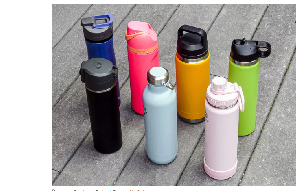To dey carry water bottle for your bag get double advantage: on one hand, dis habit dey help good level of hydration, wey dey very important for health; on di oda hand, e dey avoid too much chop-chop disposable materials, wey be positive point to sustain.
But you don ever think about di hygiene of dis utensil?
"Na only water dey di bottle, so all you go do na to rinse am under di tap bifor you fill am to keep am clean," Rodrigo Lins, one physician and consultant to di Brazilian Society of Infectious Diseases explain.
But research show say dis dey far from di case. If e no dey clean, dis containers fit gather plenti micro-organisms, like bacteria and fungi, wey dey harmful to health.
One study by WaterFilterGuru, one company wey dey do water quality control for di USA, estimate say single reusable bottle fit carry around 20.8 million CFUs (colony-forming units)..
CFU na measurement wey show di number of microbes, wey fit form colony, for one surface.
Di study bin compare di contamination level of water bottle wit number of oda objects wey, wey for first look, show much dirty.
Dem find, for example, average of 515 CFU for di surface of di toilet seat, e mean say di bottle carry 40,000 times more bacteria dan toilet bowl.
Numbers also dey really lower for di pet food can (1.4 million CFU on average), di computer mouse (4 million) and di kitchen sink (11 million).
A study by sabi pipo from Henan University, China, don conclude say e get "really high level of bacterial content and rapid microbial growth" for dis utensils.
Di authors estimate say average of 75,000 bacteria per milliliter of water, and say dis microscopic creatures fit multiply up to 2 million/ml within just 24 hours.
Anoda study, by Purdue University for USA, collect 90 bottles and find say around 15% of participants never throwey leftover water for end of di day, and just add more di next time dey use am.
Di WaterFilterGuru survey also show some hygiene issues: while 42% of participants say dem wash di bottle at least once a day, 25% tok say dey clean few times inside one week", while 13% bin admit to cleaning am " few times for one month".
But wit di danger of dirty bottle, and how you go fit keep am clean?
Na bacteria pit?
We must sabi say we dey live for sorrounding of bacteria everywia, wey no really be bad tin (sometimes, na welcome and key tin for our own survival).
Dis microscopic creatures fit "invade" our water bottles in number of ways.
Di first and most obvious na wen we dey bring our mouths close to di bottle to drink di liquid.
Some of di microbes wey colonize our skin, lips, gums, teeth and tongue, like staphylococci and streptococci, "jump" to utensil and begin to multiply for dis new environment.
One similar tin happun wen we use our fingers to pick up di container or unscrew di lid to access di water.
Our hands dey contact wit number of oda objects (door handles, elevator buttons, handrails...) wey also dey handled by oda pipo.
Bacteria fit also dey for bags and backpacks for di bottle, for school lockers, on top desk, for kitchen sink.
Once e dey container, dis microbes form colonies and begin multiply for geometric progression if dem no check am through time to time cleaning. According to di Chinese study, dey fit go from 75,000/ml to 2 million/ml inside just 24 hours.
One moist, warm and dark environment (for di case of plastic or aluminum bottles) na also better environment for many fungal species.
For cases wia hygiene leave plenti to like, e dey possible to see di results of dis microscopic "party" wit di naked eyes: di water accumulates debris, wey generally settle for di bottom of di bottle, and green or black spots show for surface of di cork or for hard-to-reach places like spouts and straws.
But den di kwesion dey rise: contact wit dis material present health risk?
Di answa depend on some factors, according to sabi pipo.
"We need take to account say ten times more bacteria dan cells dey our bodi," Lins explain, e also be di president of di nfectious Diseases Society of di State of Rio de Janeiro.
"E depend on di amount and type of microorganisms wey dey ingested, our immune system fit cope wit dis demand without major wahala," e add.
For some cases, for example wen di number of microbes for di bottle dey very high, di owner of di utensil fit experience small inside belle symptoms like nausea and vomiting.
Alternative na , dey fit dey unlucky enough to find say dia bottle dey colonized by more serious bacteria, wey fit cause serious infections wey difficult to treat wit standard antibiotics.
Some pipo also dey allergic to fungi and molds. For dem, to use water tank wey full of dis micro-organisms fit casue reactions, wit nasal congestion, nausea, headaches and fatigue, among oda discomforts.
Microbiologist Jorge Timenetsky, from di Institute of Biomedical Sciences for di University of São Paulo (ICB-USP), explain say some groups dey danger pass and sake of dat fit need to pay more attention to di hygiene of personal items.
"Dis na case for young pikins dem, di elderly or pipo wit weak immune systems," e explain.
Daily cleaning
But how you clean your water bottle wella without making life more difficult?
Di experts first recommend say. "Ideally, you need wash am every time you use am," says Lins.
"To clean once a day wen you get home dey enough",Timenetsky agree.
To combat bacteria, just use soap and water, di same products wey you dey use for di rest of di dishes.
"E also deyvimportant to use brushes to mechanically remove micro-organisms," di ICB-USP professor add.
Den leave am to dry for some time bifor you refill wit water for new hydration cycle.
Dey need get dia own bottle) and no fill di container wit oda liquids, like juices, sports drinks and sodas, as dey carry nutrients wey fit "stimulate" microbial colonies.
Di material wey dem dey use do di bottles dey influence di level of contamination? Auminum, plastic or glass get advantages or disadvantages?
According to sabi pipo, di choice depend on individual preferences, since dis compounds get similar characteristics to dey gather microscopic organisms.
Di Purdue University study wey dem tok for up bin shaow say di glass bottles wey dem collect for di experiment get lower level of micro-organisms dan di aluminum bottles.
Timenetsky suggest say to avoid containers wit grooves or rough edges, as dey fit trap more organic matter.
Lins no recommend bottles wit wooden parts (wey dey unusual for dis case). "Also, di simpler deymdey, di easier e dey to clean," e add.
For oda words, cups and bottles wit spouts, straws and oda small structures dey against, but dey need more attention to hygiene.
You fit need to buy small, flexible brushes to reach dis small parts, wey almost impossible to clean wit normal sponge.
BBC Pidgin of Sunday, 7 July 2024
Source: BBC




















